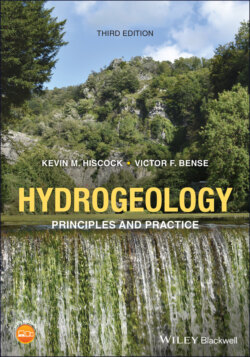Читать книгу Hydrogeology - Kevin M. Hiscock - Страница 2
Table of Contents
Оглавление1 Cover
2 Series Page
3 Title Page
4 Copyright Page
5 List of colour plates
6 List of boxes
7 Preface to the third edition
8 Preface to the second edition
9 Preface to the first edition
10 Acknowledgements
11 Symbols and abbreviations
12 About the companion website
13 1 Introduction 1.1 Scope of this book 1.2 What is hydrogeology? 1.3 Early examples of groundwater exploitation 1.4 History of hydrogeology 1.5 The water cycle 1.6 Global groundwater resources 1.7 Groundwater resources in developed countries 1.8 Groundwater resources in developing countries Further reading References
14 2 Physical hydrogeology 2.1 Introduction 2.2 Porosity 2.3 Hydraulic conductivity 2.4 Isotropy and homogeneity 2.5 Aquifers, aquitards and aquicludes 2.6 Darcy’s Law 2.7 Groundwater potential and hydraulic head 2.8 Interpretation of hydraulic head and groundwater conditions 2.9 Transmissivity and storativity of confined aquifers 2.10 Transmissivity and specific yield of unconfined aquifers 2.11 Equations of groundwater flow 2.12 Analytical solution of one‐dimensional groundwater flow problems 2.13 Groundwater flow patterns 2.14 Classification of springs and intermittent streams 2.15 Transboundary aquifer systems 2.16 Submarine groundwater discharge 2.17 Groundwater resources of the world 2.18 Hydrogeological environments of the United Kingdom Further reading References
15 3 Groundwater and geological processes 3.1 Introduction 3.2 Geological processes driving fluid flow 3.3 Topography‐driven flow in the context of geological processes 3.4 Compaction‐driven fluid flow 3.5 Variable‐density driven fluid flow 3.6 Regional groundwater flow systems driven predominantly by variable‐density flow 3.7 Regional groundwater flow systems driven predominantly by shifting topography and stress changes 3.8 Coupling and relative importance of processes driving fluid flow Further reading References
16 4 Chemical hydrogeology 4.1 Introduction 4.2 Properties of water 4.3 Chemical composition of groundwater 4.4 Sequence of hydrochemical evolution of groundwater 4.5 Groundwater sampling and graphical presentation of hydrochemical data 4.6 Concept of chemical equilibrium 4.7 Carbonate chemistry of groundwater 4.8 Adsorption and ion exchange 4.9 Redox chemistry 4.10 Groundwater in crystalline rocks 4.11 Geochemical modelling Further reading References
17 5 Environmental isotope hydrogeology 5.1 Introduction 5.2 Stable isotope chemistry and nomenclature 5.3 Stable isotopes of water 5.4 Stable isotopes of nitrogen and sulphur 5.5 Age dating of groundwater 5.6 Noble gases Further reading References
18 6 Groundwater and catchment processes 6.1 Introduction 6.2 Water balance equation 6.3 Precipitation and evapotranspiration 6.4 Soil water and infiltration 6.5 Recharge estimation 6.6 Stream gauging techniques 6.7 Hydrograph analysis 6.8 Surface water – groundwater interaction Further reading References
19 7 Groundwater investigation techniques 7.1 Introduction 7.2 Measurement and interpretation of groundwater level data 7.3 Field estimation of aquifer properties 7.4 Remote sensing methods 7.5 Groundwater modelling Further reading References
20 8 Groundwater quality and contaminant hydrogeology 8.1 Introduction 8.2 Water quality standards 8.3 Transport of contaminants in groundwater 8.4 Sources of groundwater contamination Further reading References
21 9 Groundwater pollution remediation and protection 9.1 Introduction 9.2 Groundwater pollution remediation techniques 9.3 Groundwater pollution protection strategies in developed countries 9.4 Groundwater protection strategies in developing countries Further reading References
22 10 Groundwater resources, governance and management 10.1 Introduction 10.2 Groundwater resources schemes 10.3 Wetland hydrogeology 10.4 Climate change and groundwater resources 10.5 Groundwater and energy resources 10.6 Future challenges for groundwater governance and management Further reading References
23 Appendix 1: Conversion factors
24 Appendix 2: Properties of water in the range 0–100°C
25 Appendix 3: The geological timescale
26 Appendix 4: Symbols, atomic numbers and atomic weights
27 Appendix 5: Composition of seawater and rainwater A5.1 Seawater composition A5.2 Rainwater composition References
28 Appendix 6: Values of W(u) for various values of u
29 Appendix 7: Values of q/Q and v/Qt corresponding to selected values of t/F for use in computing the rate and volume of stream depletion by wells and boreholes
30 Appendix 8: Complementary error function
31 Appendix 9: Drinking water quality standards and Lists I and II substances
32 Appendix 10: Review questions and exercises Questions A10.1 Hydrological cycle A10.2 Physical hydrogeology, groundwater potential and Darcy's law A10.3 Chemical hydrogeology A10.4 Environmental isotope hydrogeology A10.5 Stream gauging, infiltration measurements and groundwater recharge estimation A10.6 Groundwater resources, pumping tests and stream depletion analysis A10.7 Contaminant hydrogeology Worked answers to exercises A10.1 Hydrological cycle A10.2 Physical hydrogeology, groundwater potential and Darcy's law A10.3 Chemical hydrogeology A10.4 Environmental isotope hydrogeology A10.5 Stream gauging, infiltration measurements and groundwater recharge estimation A10.6 Groundwater resources, pumping tests and stream depletion analysis A10.7 Contaminant hydrogeology References
33 Index
34 Supplemental Images
35 End User License Agreement
